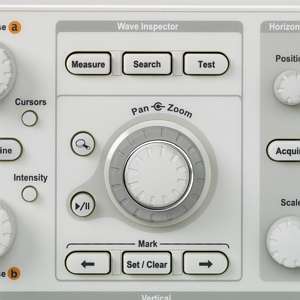
联系我们
与泰克代表实时聊天。 工作时间:上午 9:00 - 下午 5:00(太平洋标准时间)。
电话
致电我们
工作时间:上午9:00-下午5:00(太平洋标准时间)
下载
下载手册、产品技术资料、软件等:
反馈
DPO4000 Series Digital Phosphor Oscilloscopes Datasheet
DPO4000 Series
泰克对于本技术资料上的产品不再有售。
查看 Tektronix Encore 了解翻新测试设备。
查看这些产品的支持和保修状态。
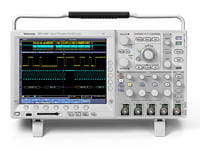
Features & Benefits
- 1 GHz, 500, 350 MHz Bandwidth Models
- 4-channel Models
- Sample Rates up to 5 GS/s on All Channels
- 10 Megasample Record Length on All Channels
- 50,000 wfms/s Maximum Waveform Capture Rate
- Wave Inspector® Controls Provide Unprecedented Efficiency in Waveform Analysis
- I2C, SPI, CAN, LIN, FlexRay, and RS-232/422/485/UART Serial Triggering and Analysis Options
- 10.4 in. (264 mm) XGA Color Display
- Small Footprint and Lightweight - Only 5.4 in. (137 mm) Deep and 11 lb. (5 kg)!
- USB and CompactFlash on Front Panel for Quick and Easy Storage
- Built-in Ethernet Port
- Plug ‘n’ Play Connectivity and Analysis Software Solutions
- USB 2.0 Device Port for Direct PC Control of Oscilloscope using USBTMC
- Suite of Advanced Triggers
- e*Scope® Remote Viewing and Control
- Interoperability with Tektronix Logic Analyzers
- TekVPI™ Probe Interface Supports Active, Differential, and Current Probes for Automatic Scaling and Units
- HDTV and Custom Video Trigger Option
Applications
- Embedded Design and Debug
- Investigation of Transient Phenomena
- Power Measurements
- Video Design and Debug
- Spectral Analysis
- Automotive Electronics Design and Debug
- Manufacturing Test and Quality Control
- Electromechanical Design and Analysis
- Biomedical Product Development
- Industrial Control
DPO4000 Series Digital Phosphor Oscilloscopes –Debug Smarter, Not Harder!
Wave Inspector® Controls

Wave Inspector® controls provide unprecedented efficiency in viewing, navigating, and analyzing waveform data.
Imagine trying to efficiently use the Internet if search engines such as Google and Yahoo didn’t exist, web browser features such as Favorites and Links didn’t exist, or Internet Service Providers like AOL or MSN weren’t around. Now you know how most modern oscilloscope users feel when trying to actually use the long record length in their digital oscilloscope. Record length, one of the key specifications of an oscilloscope, is the number of samples it can digitize and store in a single acquisition. The longer the record length, the longer the time window you can capture with high resolution (high sample rate). The first digital oscilloscopes could capture and store only 500 points which made it very difficult to acquire all relevant information around the event being investigated. Over the years, oscilloscope vendors have provided longer and longer record lengths to meet market demands for long capture windows with high resolution to the point that most midrange oscilloscopes either come standard with, or can be optionally upgraded to, multi-megapoint record lengths. These megapoint record lengths often represent thousands of screens worth of signal activity. While standard record lengths have increased greatly over the years and can now satisfy the vast majority of applications in the marketplace, tools for effectively and efficiently viewing, navigating, and analyzing long record length acquisitions have been sorely neglected until now. The DPO4000 Series redefines expectations for working with long record lengths with the following innovative new Wave Inspector® controls:
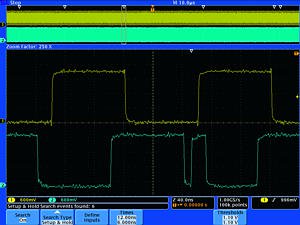
Setup and Hold search highlighting numerous setup and hold violations in a single acquisition.
Zoom/Pan - A dedicated, two-tier front-panel knob provides intuitive control of both zooming and panning. The inner knob adjusts the zoom factor (or zoom scale); turning it clockwise activates zoom and goes to progressively higher zoom factors, while turning it counter-clockwise results in lower zoom factors and eventually turning zoom off. The outer knob pans the zoom box across the waveform to quickly get to the portion of the waveform you are interested in. The outer knob also utilizes force-feedback to determine how fast to pan on the waveform. The farther you turn the outer knob, the faster the zoom box moves. Pan direction is changed by simply turning the knob the other way. No longer do you need to navigate through multiple menus to adjust your zoom view.
Play/Pause - A dedicated play/pause button on the front panel scrolls the waveform across the display automatically while you look for anomalies or an event of interest. Playback speed and direction are controlled using the intuitive pan knob. Once again, turning the knob further makes the waveform scroll faster and changing direction is as simple as turning the knob the other way.
User Marks - See something interesting on your waveform? Press the Set Mark button on the front panel to leave one or more “bookmarks” on the waveform. Navigating between marks is as simple as pressing the Previous (←) and Next (→) buttons on the front panel.
Search Marks - Don’t want to take the time to inspect the entire acquisition to find the event you’re looking for? The DPO4000 Series features a robust waveform search feature that allows you to search through your long acquisition based on user-defined criteria. All occurrences of the event are highlighted with search marks and are easily navigated to, using the front panel Previous (←) and Next (→) buttons. Search types include edge, pulse width, runt, logic, setup and hold, rise/fall time, and I2C, SPI, CAN, LIN, FlexRay, and RS-232/422/485/UART packet content.
Serial Triggering and Analysis
One of the most common applications requiring long record length is serial data analysis in embedded system design. Embedded systems are literally everywhere. They can contain many different types of devices including microprocessors, microcontrollers, DSPs, RAM, EPROMs, FPGAs, A/Ds, D/As, and I/O. These various devices have traditionally communicated with each other and the outside world using wide parallel buses. Today, however, more and more embedded systems are replacing these wide parallel buses with serial buses due to less board space required, fewer pins, lower power, embedded clocks, differential signaling for better noise immunity, and most importantly, lower cost. In addition, there’s a large supply of off-the-shelf building-block components from reputable manufacturers, enabling rapid design development. While serial buses have a large number of benefits, they also present significant challenges that their predecessors (parallel buses) did not face. They make debugging bus and system problems more difficult, it’s harder to isolate events of interest, and it’s more difficult to interpret what is displayed on the oscilloscope screen. With the optional DPO4AUTOMAX, DPO4COMP, and DPO4EMBD modules, the DPO4000 Series addresses these problems and represents the ultimate tool for engineers working with low-speed serial buses such as I2C, SPI, CAN, Lin, FlexRay, and RS-232/422/485/UART.

Triggering on a specific data packet going across an I2C bus. Yellow waveform is data, blue waveform is clock. Bus waveform provides decoded packet content including Start, Address, Read/Write, Data, Missing Ack, and Stop.
Bus Display - Provides a higher level, combined view of the individual signals (clock, data, chip enable, etc.) that make up your bus, making it easy to identify where packets begin and end and identifying subpacket components such as address, data, identifier, CRC, etc.
Serial Triggering - Trigger on packet content such as start of packet, specific addresses, specific data content, unique identifiers, etc. on popular low-speed serial interfaces such as I2C, SPI, CAN, Lin, FlexRay, and RS-232/422/485/UART.
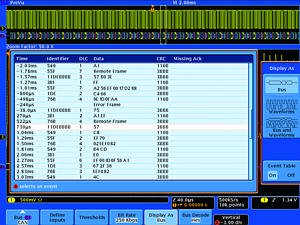
Packet decode table showing decoded Identifier, DLC, Data, and CRC for every CAN packet in a long acquisition.
Bus Decoding - Tired of having to visually inspect the waveform to count clocks, determine if each bit is a 1 or a 0, combine bits into bytes and determine the hex value? Let the oscilloscope do it for you! Once you’ve set up a bus, the oscilloscope will decode each packet on the bus, and display the value in hex, binary, decimal (LIN and FlexRay only), or ASCII (RS-232/422/485/UART only) in the bus waveform.
Event Table - In addition to seeing decoded packet data on the bus waveform itself, you can view all captured packets in a tabular view much like you would see on a logic analyzer. Packets are time stamped and listed consecutively with columns for each component (Address, Data, etc.).
Search - Serial triggering is very useful for isolating the event of interest, but once you’ve captured it and need to analyze the surrounding data, what do you do? In the past, users had to manually scroll through the waveform counting and converting bits and looking for what caused the event. With the DPO4000 Series, you can have the oscilloscope search through the acquired data for user-defined criteria including serial packet content. Each occurrence is highlighted by a search mark. Rapid navigation between marks is as simple as pressing the Previous (←) and Next (→) buttons on the front panel.
The Performance and Feature Set You Expect
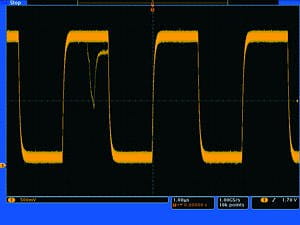
Fast waveform capture rate maximizes the probability of capturing elusive glitches and other infrequent events.
The DPO4000 Series digital phosphor oscilloscopes (DPO) deliver the performance you need to visualize even your most demanding signals. Bandwidths range from 350 MHz to 1 GHz, and with all models offering a minimum of 5x oversampling on all channels and sin(x)/x interpolation standard, you can be confident that even the fastest transient events will be captured and displayed accurately. The standard 10 M record length on all channels enables you to capture long windows of signal activity while maintaining fine timing resolution.
The DPO4000 Series offers a variety of analytical solutions including cursors, 29 automatic measurements, statistics, and waveform math. Despite a tiny footprint (only 5.4 in. deep) and light weight (11 lb.), the DPO4000 Series offers exceptional performance, a large 10.4 in. XGA display and knob per channel vertical controls.
The new TekVPI™ probe interface sets the standard for ease of use in probing. TekVPI probes feature status indicators and controls, as well as a probe menu button right on the comp box itself. This button brings up a probe menu on the oscilloscope display with all relevant settings and controls for the probe. The TekVPI interface utilizes a new probe power management architecture enabling direct attachment of current probes without requiring a separate, bulky power supply. Finally, TekVPI probes can be controlled remotely through USB, GPIB, or Ethernet, enabling more versatile solutions in ATE environments.
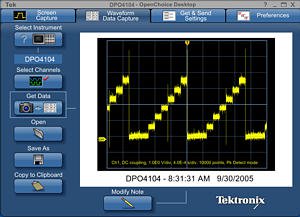
OpenChoice® Desktop – Standard software seamlessly connects the oscilloscope to a PC.
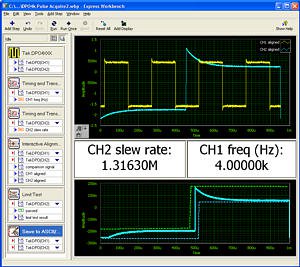
NI LabVIEW SignalExpress Tektronix Edition (SIGEXPTE) – Fully interactive measurement acquisition and analysis software developed jointly with National Instruments, and optimized for the DPO4000 Series.
The DPO4000 Series delivers an unprecedented new level of USB plug 'n' play operation and PC connectivity. Acquiring data and measurements from the instrument is as simple as connecting a USB cable from the oscilloscope to the PC. Provided applications include NI LabVIEW SignalExpress™ Tektronix Edition LE, OpenChoice® Desktop, and Microsoft Excel and Word toolbars enabling fast and easy direct communication with your Windows PC. USB and CompactFlash ports on the front panel enable simple transfer of screenshots, instrument settings, and waveform data in the palm of your hand.
The unprecedented Wave Inspector® controls, coupled with the DPO4000’s exceptional performance, comprehensive feature set, and innovative package design provide exceptional value.
Other Applications
Video Design and Development
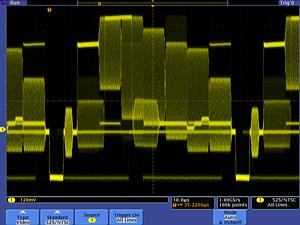
Viewing an NTSC video signal. Notice the intensity-graded view provided by the DPO’s ability to represent time, amplitude, and distribution of amplitude over time.
Many video engineers have remained loyal to analog oscilloscopes, believing the intensity gradations on an analog display are the only way to see certain video waveform details. The DPO4000 Series fast waveform capture rate, coupled with its intensity-graded view of the signal, provides the same information-rich display as an analog oscilloscope, but with much more detail and all the benefits of digital scopes.
Standard features such as IRE and mV graticules, holdoff by fields, video polarity, and an Autoset smart enough to detect video signals, make the DPO4000 Series the easiest-to-use oscilloscope on the market for video applications. And with up to 1 GHz bandwidth and four analog inputs, the DPO4000 Series provides ample performance for analog and digital video use.
Finally, the DPO4000 Series video functionality is further extended with the optional DPO4VID video application module. DPO4VID provides the industry's most complete suite of HDTV and custom (nonstandard) video triggers.
Digital Design and Debug
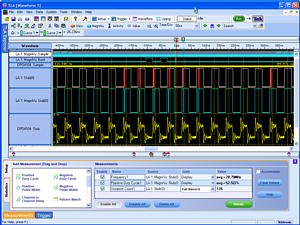
Tektronix' Integrated View feature (iView™) fully integrates the performance and measurement accuracy of a Tektronix oscilloscope with the multichannel and powerful triggering capabilities of a Tektronix logic analyzer in one display, allowing designers to quickly verify and debug their designs.
The interoperability of the DPO4000 Series oscilloscope with the Tektronix TLA5000 Series logic analyzer made possible by Tektronix' Integrated View (iView™) feature enables digital designers to solve signal integrity challenges and effectively debug and verify their systems more quickly and easily. The iView™ feature fully integrates the industry-leading performance and measurement accuracy of a Tektronix oscilloscope with the multichannel and powerful triggering capabilities of a Tektronix logic analyzer. This integration allows designers to view time-correlated digital and analog data in the same display window, and isolate analog characteristics of digital signals that are causing failures in their systems. The iView Wizard feature simplifies this integration of the oscilloscope and logic analyzer by guiding the user through setup and connection. No user calibration is required. And, once set up, the iView™ feature is completely automated. The result – an integrated tool set for digital design and troubleshooting.
Characteristics
Vertical System
|
Characteristic |
DPO4034 |
DPO4054 |
DPO4104 |
|---|---|---|---|
|
Input Channels |
4 |
4 |
4 |
|
Analog Bandwidth (-3 dB) 5 mV/div - 1 V/div |
350 MHz |
500 MHz |
1 GHz |
|
Calculated Rise Time 5 mV/div (typical) |
1 ns |
700 ps |
350 ps |
|
Hardware Bandwidth Limits |
20 MHz or 250 MHz |
||
|
Input Coupling |
AC, DC, GND |
||
|
Input Impedance |
1 MΩ ±1%, 50 Ω ±1% |
||
|
Input Sensitivity, 1 MΩ |
1 mV/div to 10 V/div |
||
|
Input Sensitivity, 50 Ω |
1 mV/div to 1 V/div |
||
|
Vertical Resolution |
8 bits (11 bits with Hi Res) |
||
|
Max Input Voltage, 1 MΩ |
250 VRMS with peaks ≤ ±400 V |
||
|
Max Input Voltage, 50 Ω |
5 VRMS with peaks ≤ ±20 V |
||
|
DC Gain Accuracy |
±1.5% with offset set to 0 V |
||
|
Offset Range |
1 MΩ |
50 Ω |
|
|
1 mV/div to 50 mV/div |
±1 V |
±1 V |
|
|
50.5 mV/div to 99.5 mV/div |
±0.5 V |
±0.5 V |
|
|
100 mV/div to 500 mV/div |
±10 V |
±10 V |
|
|
505 mV/div to 995 mV/div |
±5 V |
±5 V |
|
|
1 V/div to 5 V/div |
±100 V |
±5 V |
|
|
5.05 V/div to 10 V/div |
±50 V |
NA |
|
|
Channel-to-Channel Isolation |
≥100:1 at ≤100 MHz and ≥30:1 at >100 MHz up to the rated bandwidth for any two channels having equal volts/div settings |
||
Horizontal System
|
Characteristic |
DPO4034 |
DPO4054 |
DPO4104 |
|---|---|---|---|
|
Maximum Sample Rate (all channels) |
2.5 GS/s |
2.5 GS/s |
5 GS/s |
|
Maximum Record Length (all channels) |
10 M points |
||
|
Maximum Duration at Highest Sample Rate (all channels) |
4 ms |
4 ms |
2 ms |
|
Time Base Range (s/div) |
1 ns to 400 s |
400 ps to 400 s |
|
|
Time Base Delay Time Range |
-10 divisions to 50 s |
||
|
Channel-to-Channel Deskew Range |
±100 ns |
||
|
Time Base Accuracy |
±5 ppm over any ≥1 ms interval |
||
Trigger System
|
Characteristic |
Description |
|---|---|
|
Main Trigger Modes |
Auto, Normal, and Single |
|
Trigger Coupling |
DC, HF reject (attenuates >50 kHz), LF reject (attenuates |
|
Trigger Holdoff Range |
20 ns to 8 s |
|
Sensitivity |
|
|
Internal DC Coupled |
0.4 div DC to 50 MHz increasing to 1 div at rated bandwidth |
|
External (auxiliary input) |
200 mV from DC to 50 MHz increasing to 500 mV at 250 MHz |
|
Trigger Level Range |
|
|
Any Channel |
±8 divisions from center of screen |
|
External (auxiliary input) |
±8 V |
Acquisition Modes
|
Mode |
Description |
|---|---|
|
Sample |
Acquire sampled values |
|
Peak Detect |
Captures glitches as narrow as 200 ps at all sweep speeds |
|
Averaging |
From 2 to 512 waveforms included in average |
|
Envelope |
Min-max envelope reflecting Peak Detect data over multiple acquisitions |
|
Hi Res |
Real-time boxcar averaging reduces random noise and increases resolution |
|
Roll |
Scrolls waveforms right to left across screen at sweep speeds slower than or equal to 40 ms/div |
Trigger Modes
|
Mode |
Description |
|---|---|
|
Edge |
Positive or negative slope on any channel or front-panel auxiliary input. Coupling includes DC, HF reject, LF reject, and noise reject |
|
Pulse Width |
Trigger on width of positive or negative pulse that are >, |
|
Runt |
Trigger on a pulse that crosses one threshold but fails to cross a second threshold before crossing the first again |
|
Logic |
Trigger when any logical pattern of channels goes false or stays true for specified period of time. Any input can be used as a clock to look for the pattern on a clock edge. Pattern (AND, OR, NAND, NOR) specified for four input channels defined as High, Low, or Don't Care |
|
Setup and Hold |
Trigger on violations of both setup time and hold time between clock and data present on any two input channels |
|
Rise/Fall Time |
Trigger on pulse edge rates that are faster or slower than specified. Slope may be positive, negative, or either |
|
Video |
Trigger on all lines, odd, even, or all fields on NTSC, PAL, and SECAM video signals |
|
Extended Video (optional) |
Trigger on 480p/60, 576p/50, 720p/30, 720p/50, 720p/60, 875i/60, 1080i/50, 1080i/60, 1080p/24, 1080p/24sF, 1080p/25, 1080p/30, 1080p/50, 1080p/60, and custom bi-level and tri-level sync video standards |
|
I2C (optional) |
Trigger on Start, Repeated Start, Stop, Missing ACK, Address (7 or 10 bit), Data, or Address and Data on I2C buses up to 3.4 Mb/s |
|
SPI (optional) |
Trigger on SS, Idle Time, MOSI, MISO, or MOSI and MISO on SPI buses up to 10.0 Mb/s |
|
CAN (optional) |
Trigger on Start of Frame, Frame Type (data, remote, error, overload), Identifier (standard or extended), Data, Identifier and Data, End of Frame, or Missing ACK, or Bit Stuffing Errors on CAN signals up to 1 Mb/s. Data can be further specified to trigger on ≤, , ≥, or ≠ a specific data value. User-adjustable sample point is set to 50% by default |
|
RS-232/422/485/UART (optional) |
Trigger on Tx Start Bit, Rx Start Bit, Tx End of Packet, Rx End of Packet, Tx Data, and Rx Data |
|
LIN (optional) |
Trigger on Sync, Identifier, Data, Identifier and Data, Wakeup Frame, Sleep Frame, or Errors such as Sync, Parity, or Checksum Errors |
|
FlexRay (optional) |
Trigger on Start of Frame, Type of Frame (Normal, Payload, Null, Sync, Startup), Identifier, Cycle Count, Complete Header Field, Data, Identifier and Data, End of Frame or Errors such as Header CRC, Trailer CRC, Null Frame, Sync Frame, or Startup Frame Errors. |
|
Trigger Delay by Time |
4 ns to 8 s |
|
Trigger Delay by Events |
1 to 9,999,999 events |
Waveform Measurements
|
Characteristic |
Description |
|---|---|
|
Cursors |
Waveform and Screen |
|
Automatic Measurements |
29, of which up to eight can be displayed on screen at any one time. Measurements include Period, Frequency, Delay, Rise Time, Fall Time, Positive Duty Cycle, Negative Duty Cycle, Positive Pulse Width, Negative Pulse Width, Burst Width, Phase, Positive Overshoot, Negative Overshoot, Peak to Peak, Amplitude, High, Low, Max, Min, Mean, Cycle Mean, RMS, Cycle RMS, Positive Pulse Count, Negative Pulse Count, Rising Edge Count, Falling Edge Count, Area, and Cycle Area |
|
Measurement Statistics |
Mean, Min, Max, Standard Deviation |
|
Reference Levels |
User-definable reference levels for automatic measurements can be specified in either percent or units |
|
Gating |
Isolate the specific occurrence within an acquisition to take measurements, on using either the screen or waveform cursors |
Waveform Math
|
Option |
Description |
|---|---|
|
Arithmetic |
Add, subtract, multiply, and divide waveforms |
|
Math Functions |
Integrate, Differentiate, FFT |
|
FFT |
Spectral magnitude. Set FFT Vertical Scale to Linear RMS or dBV RMS, and FFT Window to Rectangular, Hamming, Hanning, or Blackman-Harris |
|
Advanced Math |
Define extensive algebraic expressions including waveforms, math functions, scalars, up to two user-adjustable variables, and results of parametric measurements e.g. (Intg(Ch1-Mean(Ch1)) × 1.414 × VAR1) |
Software
|
Application |
Description |
|---|---|
|
NI LabVIEW SignalExpress™ Tektronix Edition LE |
A fully interactive measurement software environment optimized for the DPO4000 Series, enables you to instantly acquire, generate, analyze, compare, import, and save measurement data and signals using an intuitive drag-and-drop user interface that does not require any programming. Standard DPO4000 Series support for acquiring, controlling, viewing, and exporting your live signal. The full version (SIGEXPTE) adds additional signal processing, advanced analysis, mixed signal, sweeping, limit testing, and user-defined step capabilities and is available for a 30-day trial period standard with each instrument |
|
OpenChoice® Desktop |
Enables fast and easy communication between a Windows PC and the DPO4000 Series, through USB or LAN. Transfer and save settings, waveforms, measurements, and screen images. |
|
IVI Driver |
Provides a standard instrument programming interface for common applications such as LabVIEW, LabWindows/CVI, Microsoft .NET, and MATLAB |
Display Characteristics
|
Characteristic |
Description |
|---|---|
|
Display Type |
10.4 in. (264 mm) liquid-crystal TFT color display |
|
Display Resolution |
1,024 (H) × 768 (V) pixels (XGA) |
|
Waveform Styles |
Vectors, Dots, Variable Persistence, Infinite Persistence |
|
Graticules |
Full, Grid, Cross Hair, Frame, IRE, and mV |
|
Format |
YT and simultaneous XY/YT |
|
Waveform Capture Rate |
Up to 50,000 wfms/s |
Input/Output Ports
|
Port |
Description |
|---|---|
|
CompactFlash Drive |
Front-panel access (Type 1) |
|
USB 2.0 Full-speed Host Port |
Supports USB mass storage devices and printers. Two ports available on rear panel and one on front panel |
|
USB 2.0 High-speed Device Port |
Rear-panel connector allows for control of oscilloscope through USBTMC or GPIB with a TEK-USB-488 |
|
LAN Port |
RJ-45 connector, supports 10/100Base-T |
|
XGA Video Port |
DB-15 female connector, connect to show the oscilloscope display on an external monitor or projector |
|
Auxiliary Input |
Front-panel BNC connector. Input Impedance 1 MΩ. Max input 250 VRMS with peaks ≤ ±400 V |
|
Probe Compensator Output |
Front-panel pins. Amplitude 2.5 V. Frequency 1 kHz |
|
Trigger Out |
Rear-panel BNC connector, provides a positive polarity pulse when the oscilloscope triggers |
|
Kensington Lock |
Rear-panel security slot connects to standard Kensington lock |
Power Source
|
Characteristic |
Description |
|---|---|
|
Power Source Voltage |
100 to 240 V ±10% |
|
Power Source Frequency |
47 – 66 Hz (90 to 264 V) 360 – 440 Hz (100 to 132 V) |
|
Power Consumption |
250 W maximum |
General Characteristics
Physical Characteristics
|
Dimensions |
mm |
in. |
|---|---|---|
|
Height |
229 |
9.0 |
|
Width |
439 |
17.3 |
|
Depth |
137 |
5.4 |
|
Weight |
kg |
lb. |
|
Net |
5 |
11 |
|
Shipping |
10 |
22 |
|
Rackmount Configuration |
5U |
|
|
Cooling Clearance |
2 in. (51 mm) required on left side and rear of instrument |
|
Environmental
|
Characteristic |
Description |
|---|---|
|
Temperature |
|
|
Operating |
0 °C to +50 °C |
|
Nonoperating |
-20 °C to +60 °C |
|
Humidity |
|
|
Operating |
High: 40 °C to 50 °C, 10% to 60% Relative Humidity Low: 0 °C to 40 °C, 10% to 90% Relative Humidity |
|
Nonoperating |
High: 40 °C to 60 °C, 5% to 60% Relative Humidity Low: 0 °C to 40 °C, 5% to 90% Relative Humidity |
|
Altitude |
|
|
Operating |
3,000 meters (9,843 feet) |
|
Nonoperating |
12,000 meters (39,370 feet) |
|
Random Vibration |
|
|
Operating |
0.31 GRMS from 5 to 500 Hz, 10 minutes each axis, 3 axes, 30 minutes total |
|
Nonoperating |
2.46 GRMS from 5 to 500 Hz, 10 minutes each axis, 3 axes, 30 minutes total |
|
Regulatory |
|
|
Electromagnetic Compatibility |
89/336/EEC |
|
Safety |
UL61010-1, Second Edition; CSA61010-1 Second Edition, EN61010-1: 2001; IEC 61010-1: 2001 |
Ordering Information
DPO4000 Series
|
Product |
Description |
|---|---|
|
DPO4034 |
350 MHz, 2.5 GS/s, 10 M record length, 4-channel digital phosphor oscilloscope |
|
DPO4054 |
500 MHz, 2.5 GS/s, 10 M record length, 4-channel digital phosphor oscilloscope |
|
DPO4104 |
1 GHz, 5 GS/s, 10 M record length, 4-channel digital phosphor oscilloscope |
All Models Include: One P6139A 500 MHz, 10x Passive Probe per Channel, Front Cover (200-4908-xx), CompactFlash Memory Card; ≥32 MB (156-9413-xx), User Manual (071-2121-xx), Documentation CD (063-3903-xx), OpenChoice® Desktop Software, NI LabView SignalExpress Tektronix Edition LE Software, Calibration Certificate Documenting Traceability to National Metrology Institute(s) and ISO9001 Quality System Registration, Power Cord, Accessory Bag (016-1967-xx), Three-year Warranty.
Please specify power plug and manual version when ordering.
Application Modules
|
Module |
Description |
|---|---|
|
DPO4EMBD |
Embedded Serial Triggering and Analysis Module. Enables triggering on packet-level information on I2C and SPI buses as well as analytical tools such as digital views of the signal, bus views, packet decoding, search tools, and packet decode tables with time-stamp information |
|
DPO4COMP |
Computer Serial Triggering and Analysis Module. Enables triggering on packet-level information on RS-232/422/485/UART buses as well as analytical tools such as digital views of the signal, bus views, packet decoding, search tools, and packet decode tables with time-stamp information |
|
DPO4AUTO |
Automotive Serial Triggering and Analysis Module. Enables triggering on packet-level information on CAN and LIN buses as well as analytical tools such as digital views of the signal, bus views, packet decoding, search tools, and packet decode tables with time-stamp information |
|
DPO4AUTOMAX |
Extended Automotive Serial Triggering and Analysis Module. Enables triggering on packet-level information on CAN, LIN, and FlexRay buses as well as analytical tools such as digital views of the signal, bus views, packet decoding, search tools, and packet decode tables with time-stamp information |
|
DPO4VID |
HDTV and Custom (nonstandard) Video Triggering Module |
Instrument Options
Power Plug Options
|
Option |
Description |
|---|---|
|
Opt. A0 |
North America |
|
Opt. A1 |
Universal Euro |
|
Opt. A2 |
United Kingdom |
|
Opt. A3 |
Australia |
|
Opt. A5 |
Switzerland |
|
Opt. A6 |
Japan |
|
Opt. A10 |
China |
|
Opt. A11 |
India |
|
Opt. A99 |
No power cord or AC adapter |
Language Options*1
|
Option |
Description |
|---|---|
|
Opt. L0 |
English Manual |
|
Opt. L1 |
French Manual |
|
Opt. L2 |
Italian Manual |
|
Opt. L3 |
German Manual |
|
Opt. L4 |
Spanish Manual |
|
Opt. L5 |
Japanese Manual |
|
Opt. L6 |
Portuguese Manual |
|
Opt. L7 |
Simplified Chinese Manual |
|
Opt. L8 |
Standard Chinese Manual |
|
Opt. L9 |
Korean Manual |
|
Opt. L10 |
Russian Manual |
|
Opt. L99 |
No Manual |
*1 Language options include translated front-panel overlay for the selected language(s).
Service Options*2
|
Option |
Description |
|---|---|
|
Opt. C3 |
Calibration Service 3 Years |
|
Opt. C5 |
Calibration Service 5 Years |
|
Opt. CA1 |
Provides a single calibration event, or coverage for the designated calibration interval, whichever comes first |
|
Opt. D1 |
Calibration Data Report |
|
Opt. D3 |
Calibration Data Report 3 Years (with Opt. C3) |
|
Opt. D5 |
Calibration Data Report 5 Years (with Opt. C5) |
|
Opt. R5 |
Repair Service 5 Years (including warranty) |
*2 Probes and accessories are not covered by the oscilloscope warranty and Service Offerings. Refer to the datasheet of each probe and accessory model for its unique warranty and calibration terms.
Recommended Probes
|
Probe |
Description |
|---|---|
|
TAP1500 |
1.5 GHz TekVPI™ active probe |
|
TAP1500X2 |
Bundle of two 1500 MHz active probes, single-ended with TekVPI Interface; Certificate of traceable calibration standard |
|
TCP0030 |
120 MHz TekVPI 30 Ampere AC/DC current probe |
|
TCP0150 |
20 MHz TekVPI 150 Ampere AC/DC current probe |
|
TCPA300/400*3 |
Current measurement systems |
|
TDP0500 |
500 MHz differential probe |
|
TDP1000 |
1 GHz differential probe |
|
P5205*3 |
1.3 kV, 100 MHz high-voltage differential probe |
|
P5210*3 |
5.6 kV, 50 MHz high-voltage differential probe |
|
P5100 |
2.5 kV, 100x high-voltage passive probe |
|
ADA400A*3 |
100x, 10x, 1x, 0.1x high-gain differential amplifier |
Recommended Accessories
|
Accessory |
Description |
|---|---|
|
Service Manual (English only) |
Order 071-1844-xx |
|
SIGEXPTE |
NI LabVIEW SignalExpress™ Tektronix Edition Software |
|
TPA-BNC |
TekVPI to TekProbe BNC adapter |
|
TEK-USB-488 |
GPIB to USB adapter |
|
CompactFlash to USB Memory Card Reader |
Order 19-6827-xx |
|
ACD4000 |
Soft transit case |
|
HCTEK4321 |
Hard transit case (requires ACD4000) |
|
RM4000 |
Rackmount Kit |
|
AMT75*3 |
1 GHz, 75 Ω adapter |
*3 Requires TekVPI to TekProbe BNC adapter (TPA-BNC).
Warranty
- Three-year warranty covering all parts and labor, excluding probes.



